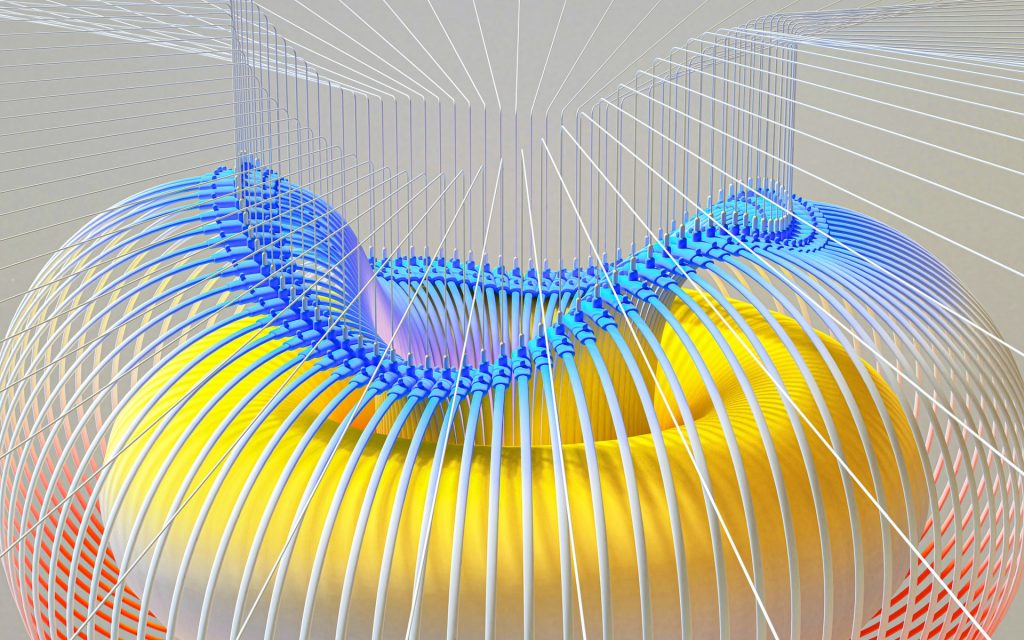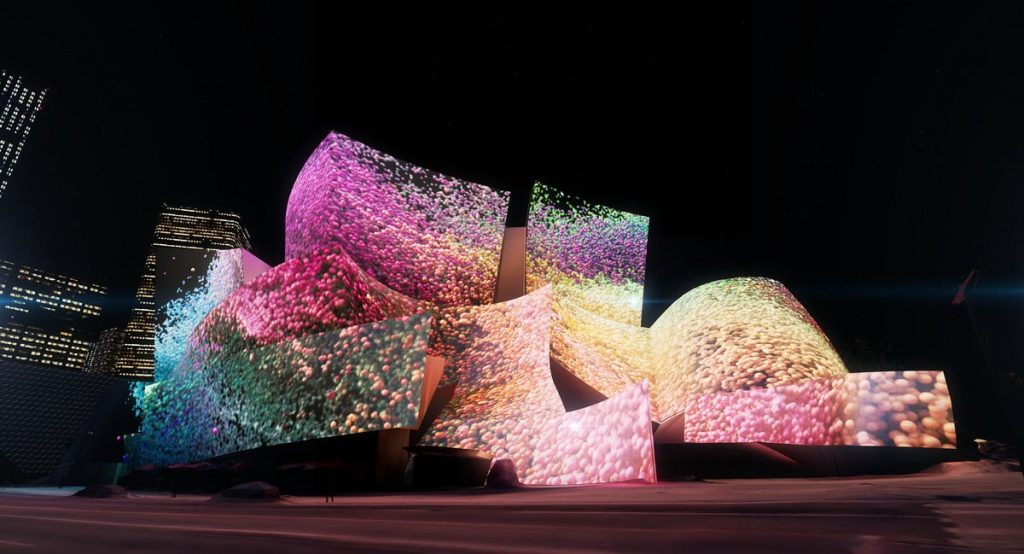When you’re new to technology as an architect or designer, it can feel like you’ve walked into a party where everyone knows what they’re talking about. You’re not the problem, it’s because our world is becoming more technologically based, and designers, must learn more technical terms than ever before. So much for Googling every time someone says “ASI,” “GARF,” or “GAN.”
Sometimes a brief and simple explanation is all that is required to grasp a new concept. And that’s precisely what we’ve got here: a tech dictionary for designers!
AI- Artificial Intelligence
Refers to the ability of machines or software to perform tasks that would normally require human intelligence, such as learning, decision-making, problem-solving, and language understanding
ANN – Artificial Neural Network
ANN is a type of machine-learning algorithm modeled after the structure and function of the human brain. ANNs consist of interconnected nodes, or “neurons,” which process and transmit information.
ANI – Artificial Narrow Intelligence
ANI refers to artificial intelligence systems that are designed to perform a specific task or function. ANI systems are specialized and can perform at or near the human level in their area of expertise, but are not capable of learning or adapting to new tasks beyond their specific domain. Examples of ANI include virtual assistants like Alexa or Siri, or image recognition systems used to identify objects in photographs.
AGI – Artificial General Intelligence
AGI refers to artificial intelligence systems that are capable of learning and adapting to new tasks and environments. AGI systems are able to perform a wide range of tasks at or near human-level intelligence, and can learn and adapt as they gain more experience. AGI is considered the next stage of AI development beyond ANI, and is sometimes referred to as “strong AI” or “human-level AI.”
ASI – Artificial Super Intelligence (Machine Conscious)
ASI refers to hypothetical artificial intelligence systems that are significantly more intelligent and capable than humans. ASI systems are often portrayed in science fiction as having the ability to surpass human intelligence in all domains and possibly even achieve self-awareness or consciousness. ASI is considered a potential future development of AI, but it is not clear when or if it will be achieved.
IA – Intelligent Automation
IA refers to the use of artificial intelligence and other technologies to automate business processes and decision-making. IA involves the integration of AI and automation technologies to perform tasks that are traditionally done by humans, such as data entry, customer service, or decision-making. The goal of IA is to improve efficiency and accuracy, and free up human workers to focus on more value-added activities. Examples of IA include robotic process automation (RPA) systems or chatbots that handle customer inquiries.
IMS – Intelligent Maintenance Systems
Systems that use AI and other technologies to optimize the maintenance of equipment and machines. IMS can monitor the performance and condition of equipment in real-time, predict when maintenance is required, and optimize maintenance schedules to minimize downtime and costs.
XAI – Explanaible Artificial Intelligence
XAI refers to AI systems that are able to provide explanations for their decisions or predictions. XAI aims to make AI systems more transparent and interpretable so that their behavior can be understood and trusted by humans. Examples of XAI include systems that provide explanations for credit approval decisions or medical diagnoses.
GenAI – Generative Artificial Intelligence
GenAI refers to AI systems that are able to generate new content or artifacts, such as images, texts, or audio. GenAI systems use machine learning techniques to model the distribution of a given data set and generate new samples that are similar to the data. Examples of GenAI include image generation systems or text generation systems that can create news articles or social media posts.
GAN – Generative Adversarial Nets
Gan’s are a type of machine learning model made up of two neural networks: a generator and a discriminator. The generator produces new data, while the discriminator determines whether the data is real or fake. The generator and discriminator are trained simultaneously, with the generator trying to produce data that is indistinguishable from the real data, and the discriminator tries to correctly identify whether the data is real or generated. GANs can be used to generate new images, texts, or audio.
GARF – Generative Radiace Fields
A type of machine learning model that is used for tasks such as image generation and manipulation. GARFs use a neural network to model the distribution of a given data set and generate new samples that are similar to the data.
Prompt
A prompt is a message or request (input) that is displayed to elicit a response or action. Prompts are an important part of the interaction between humans and AI systems, as they allow the user to control and communicate with the system in a meaningful way.
They are commonly used in computing to request input from the user in any form such as speech or text to provide instructions or guidance on what to do next; but can also be used in non-computing contexts, such as in education or therapy, to encourage the user to think or reflect on a topic, or to prompt them to take a specific action or make a decision.
T2A – Text to Audio
Text to Audio (T2A) refers to technologies or systems that are able to convert written text into spoken audio. T2A systems use natural language processing and text-to-speech synthesis techniques to generate an audio version of the text.
A2T – Audio to Text
Audio to Text (A2T) systems use speech recognition techniques to analyze the audio signal and generate a transcript of the spoken words. Examples of A2T include voice dictation systems that allow users to speak and have their words transcribed into text, or systems that can transcribe recorded audio files into text.
T2D – Text to 3D
Text to 3D (T2D) refers to technologies or systems that are able to convert written descriptions or instructions into 3D models or simulations.T2D systems are often used for applications such as creating 3D models for product design or visualization, or for generating virtual environments for training or simulation.
T2I – Text to Image
Text to Image (T2I) refers to technologies or systems that are able to generate static images from written descriptions or instructions. T2I systems are often used for applications such as generating images for social media posts or advertisements, or for creating illustrations for documents or books.
T2V – Text to Video
Text to Video (T2V) refers to technologies or systems that are able to generate videos from written descriptions or instructions. Examples of T2V include systems that can generate explainer videos based on text scripts, or systems that can convert text stories into animated videos.
T2T – Text to Text
Text to Text (T2T) refers to the process of converting written or typed text from one language or format into another using artificial intelligence. T2T systems analyze the source text and generate a translation in the target language or format. Examples of T2T include machine translation systems that can translate text from one language to another or systems that can convert the text in one format (such as HTML or Markdown) into another type.
T2M – Text to Motion
Text to Motion (T2M) refers to the process of converting written or typed text into a motion or animation using artificial intelligence. T2M systems analyze the text and generate a motion or animation based on the instructions or descriptions contained in the text. Examples of T2M include systems that can generate character animations based on text scripts, or systems that can convert text instructions into motion graphics.
T2C – Text to Code
Text to Code (T2C) systems use artificial intelligence to generate code based on the instructions or descriptions contained in the text prompt. Examples of T2C include systems that can generate code snippets or systems that can convert pseudocode or flowcharts into working code.
A2A – Audio to Audio
Audio to Audio (A2A) systems use signal processing techniques to analyze the audio signal and generate a new audio signal that is similar to the original but in a different format or representation. Examples of A2A include audio compression systems that reduce the size of an audio file by removing redundant or inaudible information or even audio enhancement systems that improve the quality of a noisy or distorted audio signal.
B2T – Brain to Text
Brain to Text (B2T) systems use neuroimaging or brain-computer interface (BCI) technologies to measure and interpret brain activity and generate text based on the observed brain activity. B2T is a highly experimental and speculative field, and it is not clear how well it will be able to translate thoughts or intentions into text in the future.
BCI – Brain-Computer Interface
A brain-computer interface (BCI) is a system that allows a person to communicate or control external devices using their brain activity. BCI systems use neuroimaging or other technologies to measure and interpret brain activity and translate it into commands or signals that can be used to control external devices or systems. BCIs are often used to help people with severe physical disabilities communicate or control their environment, but they are also being explored for other applications such as gaming, entertainment, or education.
API – Application Programming Interface
Is a set of rules and protocols that define how different software systems can communicate with each other.
DS – Data Science
Data science is a field that involves using scientific methods, processes, and systems to extract knowledge and insights from structured and unstructured data. Data scientists use a range of tools and techniques from mathematics, statistics, and computer science to analyze and interpret data, and to communicate their findings in a clear and effective way.
DPA – Digital Process Automation
Use of technology to automate business processes. DPA involves the use of software tools and platforms to streamline and automate repetitive or manual tasks, such as data entry, document processing, or customer service. The goal of DPA is to improve efficiency, reduce errors, and free up human workers to focus on more value-added activities. Examples of DPA include robotic process automation (RPA) tools or workflow management systems.
DX – Digital Transformation
The integration of digital technology into all areas of a business results in fundamental changes to how the business operates and delivers value to customers.
I/O – Input and Output
Refers to the data that is entered into a computer or device and the resulting output after the data has been processed.
IoT – Internet of Things
The Internet of Things (IoT) refers to the interconnected network of physical devices, vehicles, buildings, and other objects that are equipped with sensors, software, and network connectivity, enabling them to collect and exchange data.
IoAT – The Internet of All Things
Refers to the expansion of the IoT to include not only traditional “things” like devices and sensors, but also people, animals, and other living beings.
ML – Machine Learning
ML is a subfield of AI that involves using statistical and computational techniques to enable computers to learn from data, without being explicitly programmed, through developed algorithms.
ML algorithms can be classified into two main categories: supervised learning and unsupervised learning. Supervised learning algorithms are trained on labeled data, where the input data and the desired output are known. These algorithms can be used to make predictions or classifications. Unsupervised learning algorithms are trained on unlabeled data, where the input data is known but the desired output is not. These algorithms can be used to discover patterns or relationships in the data.
NFT – Non-Fungible Token
type of digital asset that represents ownership of a unique item or asset, such as a piece of art or a collectible. NFTs are stored on a blockchain and are unique, meaning they cannot be exchanged for other tokens or assets on a one-to-one basis.
NLP – Neural Language Programming
A subfield of artificial intelligence and linguistics that focuses on the interaction between computers and human (natural) languages. NLP techniques are used to analyze and generate text, speech, and other forms of human communication.
SOTA – State of the Art
Refers to the current highest level of development or most advanced state of technology or field.
IaaS – Infrastructure as a Service
Infrastructure as a Service (IaaS) refers to the delivery of computer infrastructure (such as servers, storage, and networking) as a service over the internet. IaaS providers offer hardware, software, and other resources on a pay-per-use or subscription basis, allowing customers to scale their infrastructure up or down as needed. Examples of IaaS include cloud-based storage and computing platforms like Amazon Web Services (AWS) or Microsoft Azure.
SaaS – Software as a Service
Software as a Service (SaaS) refers to the delivery of software applications over the internet, on a subscription basis. SaaS providers host and maintain the software on their own servers, and users access the software through a web browser or other client. Examples of SaaS include cloud-based productivity tools like Google Workspace or Microsoft 365, or customer relationship management (CRM) systems like Salesforce.
PaaS – Platform as a Service
Platform as a Service (PaaS) refers to the delivery of a computing platform (such as an operating system, database, and middleware) as a service over the internet. PaaS providers offer a platform on which users can build, deploy, and manage their own applications, without the need to maintain the underlying infrastructure. Examples of PaaS include cloud-based development platforms like Heroku or Google App Engine.
FaaS – Function as a Service
Function as a Service refers to a cloud computing model in which developers can build and deploy applications as individual functions, without the need to worry about the underlying infrastructure. FaaS providers offer a platform on which users can execute code in response to events or triggers, and only pay for the actual execution time used. Examples of FaaS include Amazon’s Lambda or Google’s Cloud Functions.
AR – Augmented Reality
Augmented Reality refers to the overlay of digital content (such as images, text, and video) onto the real world. AR technologies use sensors and algorithms to understand the user’s environment and display digital information in real-time. Examples of AR include smartphone apps that display information about nearby points of interest, or eyeglasses that display a heads-up display for the wearer.
VR – Virtual Reality
Virtual Reality refers to a computer-generated simulation of a three-dimensional environment that can be interacted with in a seemingly real or physical way. VR technologies use headsets or other devices to immerse the user in a virtual world, often with the ability to manipulate objects or interact with the environment using hand gestures or other input methods. Examples of VR include video games that use VR headsets or training simulations for military or medical personnel.
MR – Mixed Reality
Mixed Reality refers to a hybrid of augmented reality and virtual reality, in which real and virtual elements coexist and interact in the same space. MR technologies use sensors and algorithms to understand the user’s environment and display a mix of real and virtual objects that can interact with each other. Examples of MR include interactive museum exhibits that blend real and virtual elements, or training simulations that use real equipment in a virtual environment.
XR – Extended Reality
Extended Reality refers to a broad category that includes AR, VR, and MR, as well as other immersive technologies. XR technologies use sensors and algorithms to create a sense of presence in a virtual or augmented environment and often involve a high degree of interactivity and immersion. Examples of XR include virtual reality theme parks or interactive training simulations for industrial or healthcare applications.
CAD – Computer-Aided Design
Use of computer software to create, modify, analyze, or optimize design objects or systems. CAD software is commonly used in architecture, engineering, and manufacturing to create detailed plans, drawings, or models of products, buildings, or other objects. CAD software typically includes tools for drawing, dimensioning, and annotation, as well as tools for 3D modeling, simulation, and visualization.
CAE – Computer-Aided Engineering
Use of computer software to analyze, simulate or optimize engineering systems or processes. CAE software is commonly used in the design and development of products, structures, or systems to evaluate their performance, reliability, or safety. CAE software typically includes tools for the analysis and simulation of different types of systems, such as structural, thermal, fluid, or electromechanical systems.
CAM – Computer-Aided Manufacturing
Use of computer software to control or optimize manufacturing processes or systems. CAM software is commonly used in the production of products, parts, or components to automate or streamline the manufacturing process. CAM software typically includes tools for creating and managing manufacturing instructions, as well as tools for process planning, toolpath generation, and machine control.
CGI – Computer Generated Imagery
CGI typically involves the use of specialized software and hardware, such as 3D modeling software, rendering engines, and high-performance computers, to create and manipulate digital models and images. CGI can be used to create a wide range of visual effects, such as photorealistic images, stylized graphics, or abstract visualizations.
UD – Universal Design
UD refers to the design of products, environments, or systems that are usable by all people, to the greatest extent possible, without the need for adaptation or specialized design. UD principles aim to create products, environments, or systems that are inclusive, accessible, and user-friendly for people of all ages, abilities, and backgrounds. UD is often applied in the design of products or environments for the built environment, such as buildings, streets, or public spaces, as well as in the design of products or systems for personal use, such as consumer electronics, appliances, or software.
DT – Design Thinking
DT is a creative problem-solving approach that involves identifying and understanding user needs, generating and prototyping ideas, and testing and refining solutions. Design thinking is often used in the design of products, services, or experiences, and it emphasizes empathy for the user, rapid prototyping, and iteration.
CMF – Colour Material Finish
CMF is an important aspect of product design, as it can affect the perceived value, quality, and usability of the product. It is often used to create a cohesive and harmonious design for a product, and it can be influenced by factors such as the product’s intended use, target market, or brand identity.
DFA – Design for Assembly
DFA is a design approach that aims to minimize the number of parts and the complexity of assembly in a product.
DFM – Design for Manufacturing
DFM is a design approach that considers manufacturing processes and constraints during the design phase to optimize the production and costs of a product.
DMA – Design for Manufacturing and Assembly
DFMA is a design approach that combines DFA and DFM to optimize the production and assembly of a product.
DVT – Design Verification Test
DVT is a testing process that verifies that a product or system meets its design specifications.
MVP – Minimum Viable Product
MVP is a product with just enough features to allow users to experience its core functionality. MVPs are often used to test the market demand for a product and gather feedback from early users. The goal of an MVP is to quickly validate the product idea and gather insights for further development.
POC – Proof of Concept
POC is a prototype or a demonstration that is used to test the feasibility or potential value of an idea or concept. POCs are often used to explore the technical, operational, or business aspects of a new product or service.
TRL – Technology Readiness Level
TRL is a scale used to measure the maturity of a technology, ranging from TRL 1 (basic principles observed) to TRL 9 (technology demonstrated in a relevant environment). TRLs are often used to assess the readiness of a technology for further development or commercialization.
EIR – Environmental Impact Report
EIR is a document that evaluates the potential environmental impacts of a proposed project or action. EIRs are often required by law for certain types of projects and are used to inform decision-making and ensure that the project is consistent with environmental regulations and policies.
SLA – Service Level Agreement
SLA is a contract between a service provider and a customer that defines the level of service that the provider will deliver. SLAs typically specify the performance standards and service availability that the provider will commit to, as well as any remedies or credits that will be provided in the event of service failures or disruptions.
TOS – Terms of Service
TOS are the legal terms that govern the use of a product or service. ToS typically outline the rights and responsibilities of the user and the provider, as well as any limitations or restrictions on the use of the product or service.
NPS – Net Promoter Score
NPS is a measure of customer loyalty and satisfaction. NPS is calculated by asking customers to rate the likelihood of recommending a product or service on a scale of 0 to 10, and grouping the responses into three categories: promoters (9-10), passives (7-8), and detractors (0-6). The NPS is calculated by subtracting the percentage of detractors from the percentage of promoters. A high NPS is generally considered an indicator of customer satisfaction and loyalty.








































Leave a comment